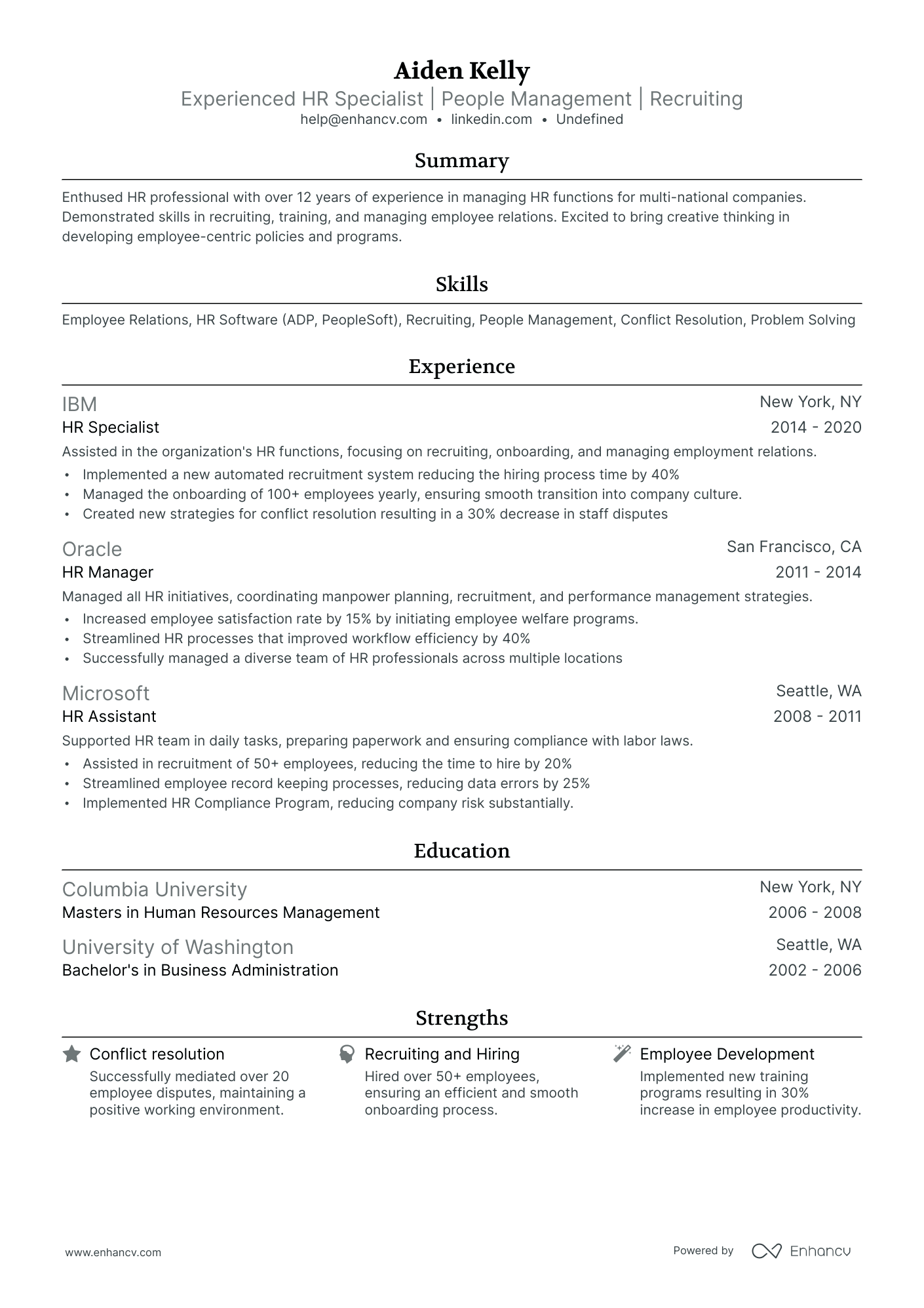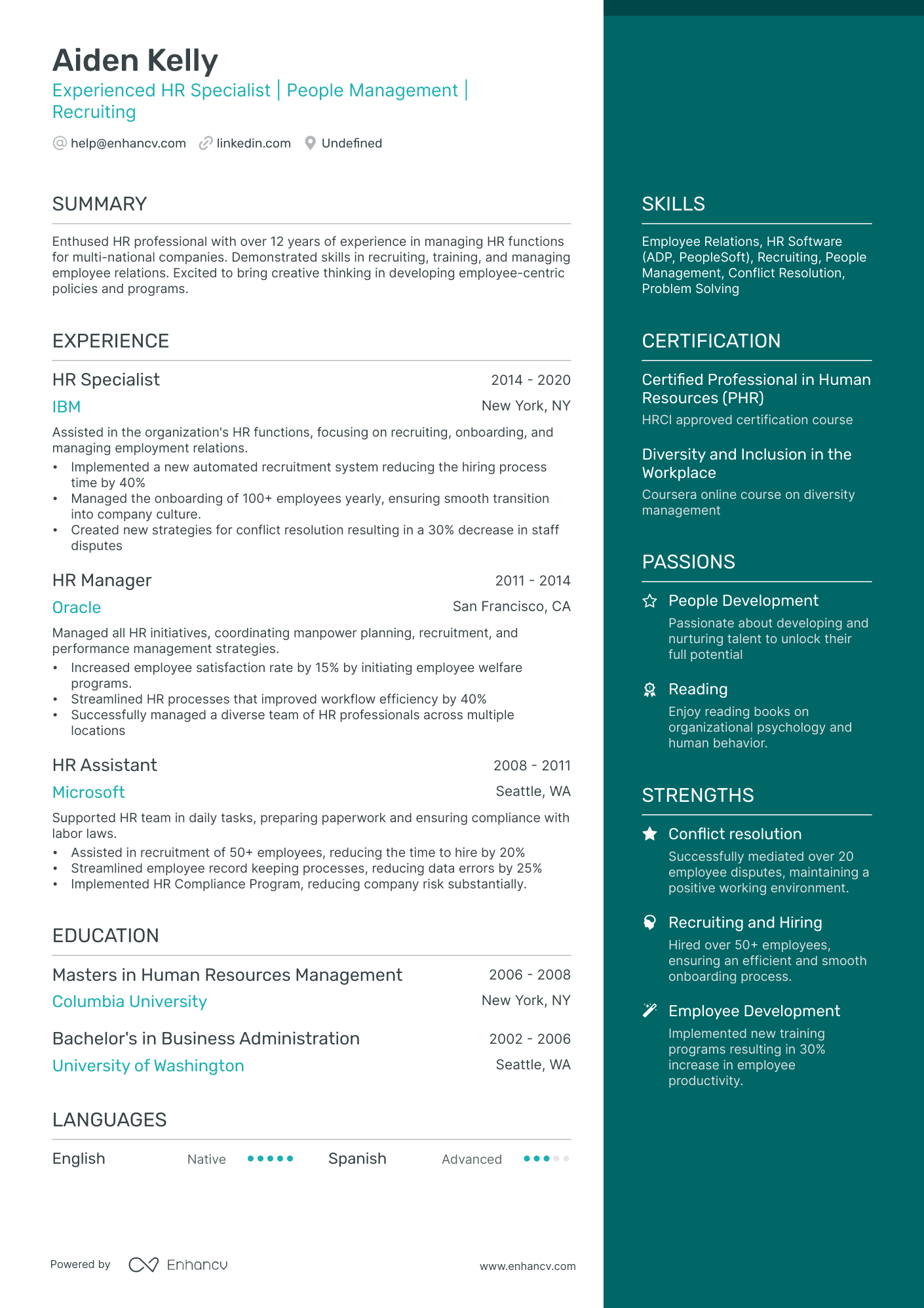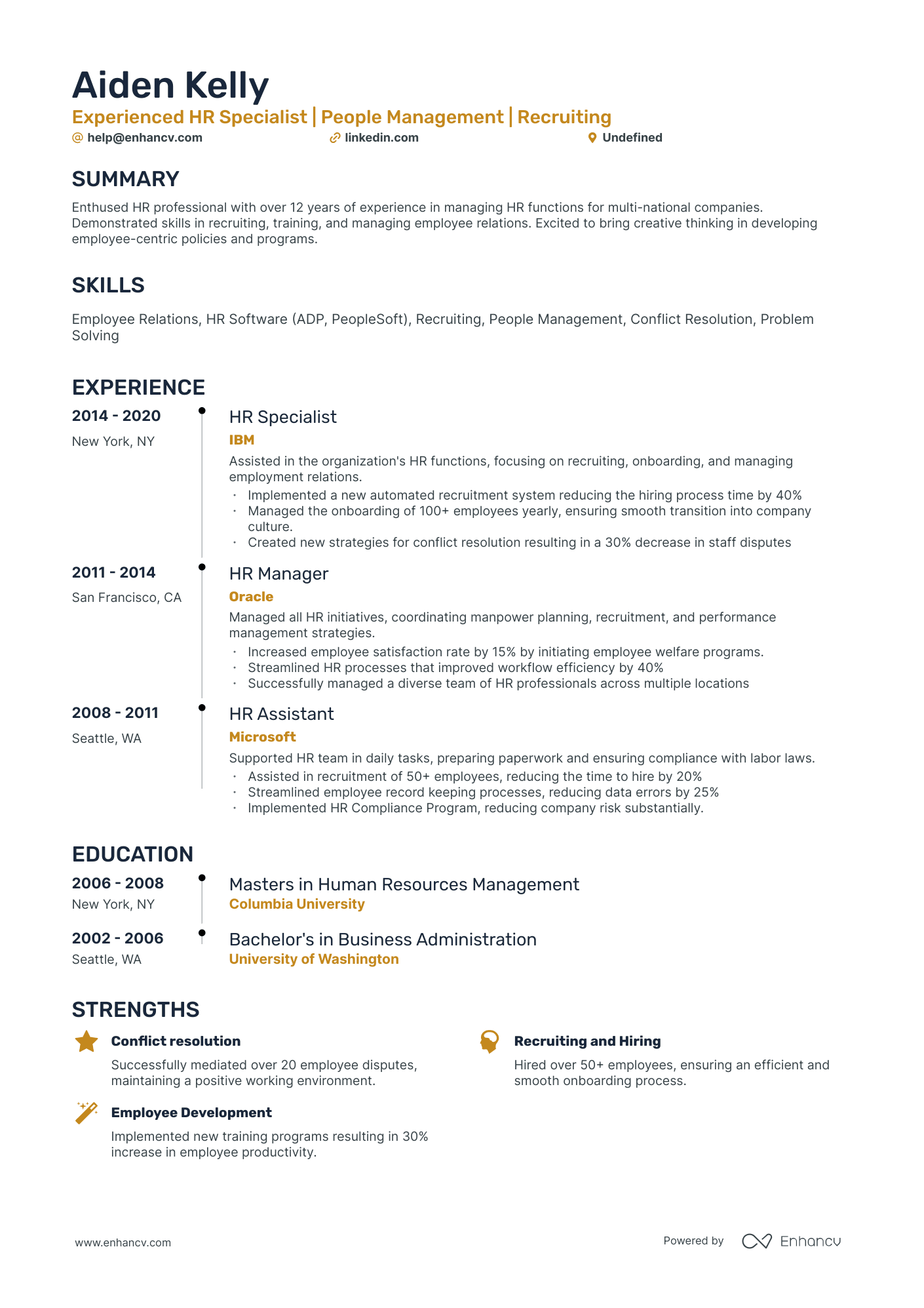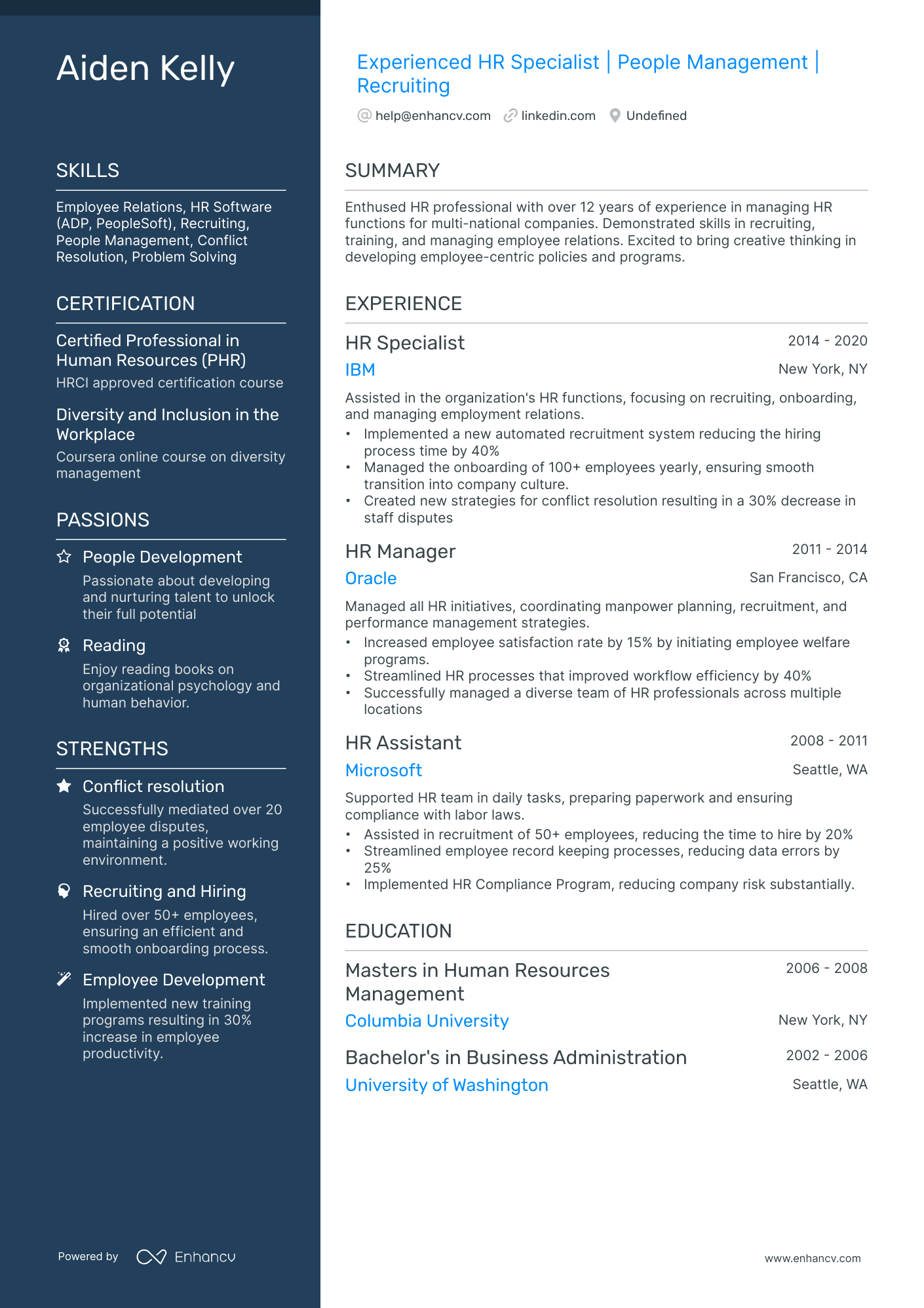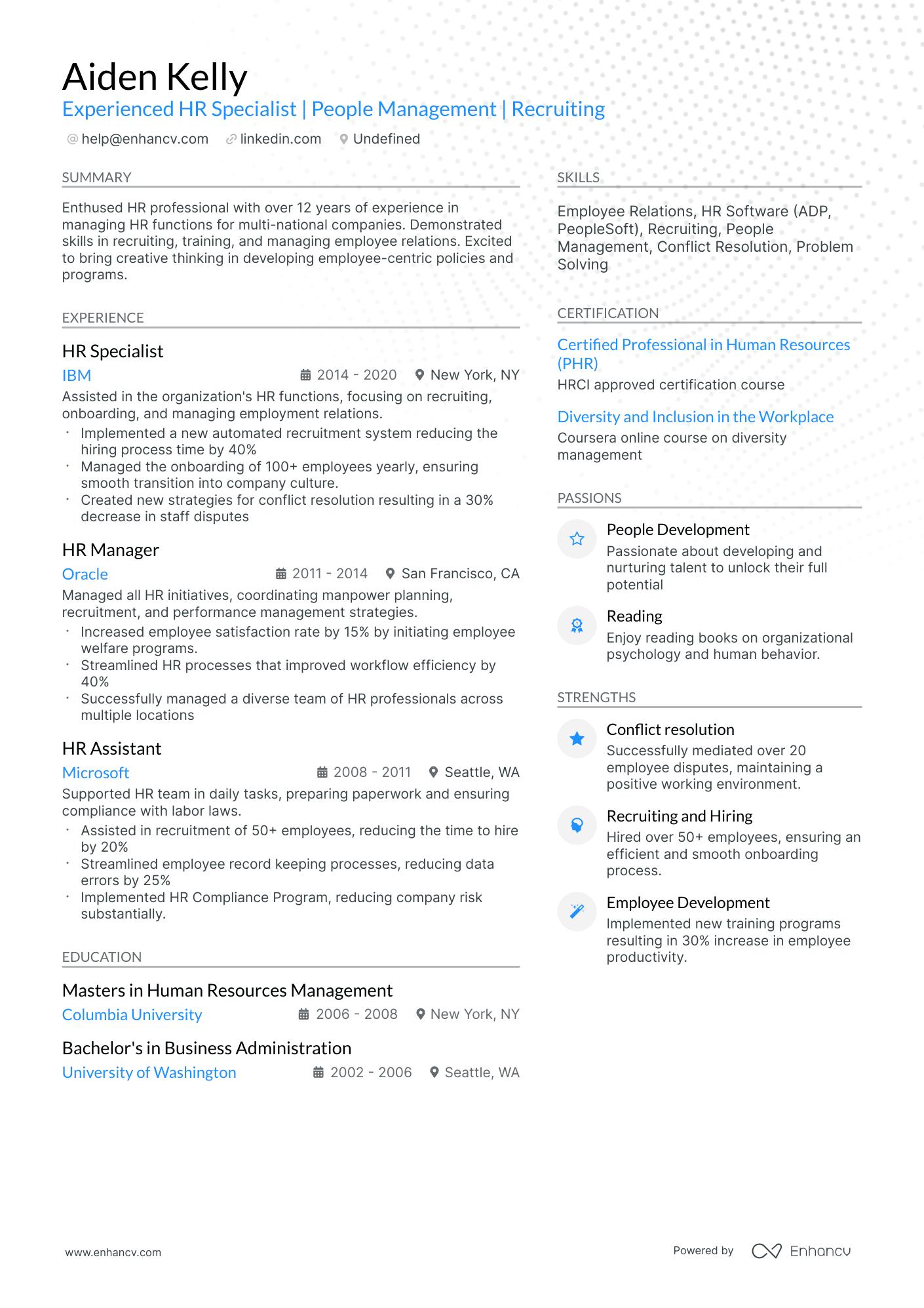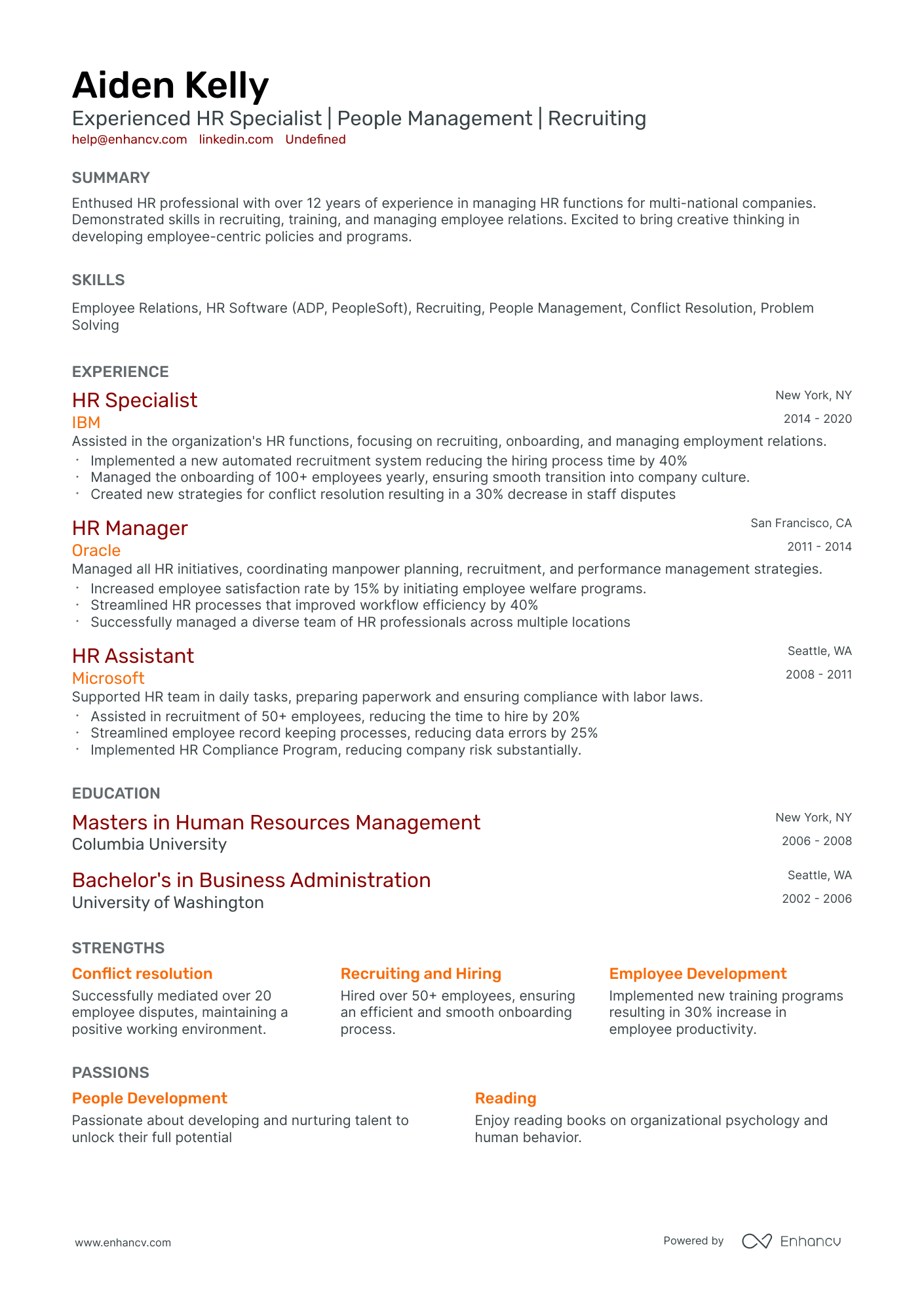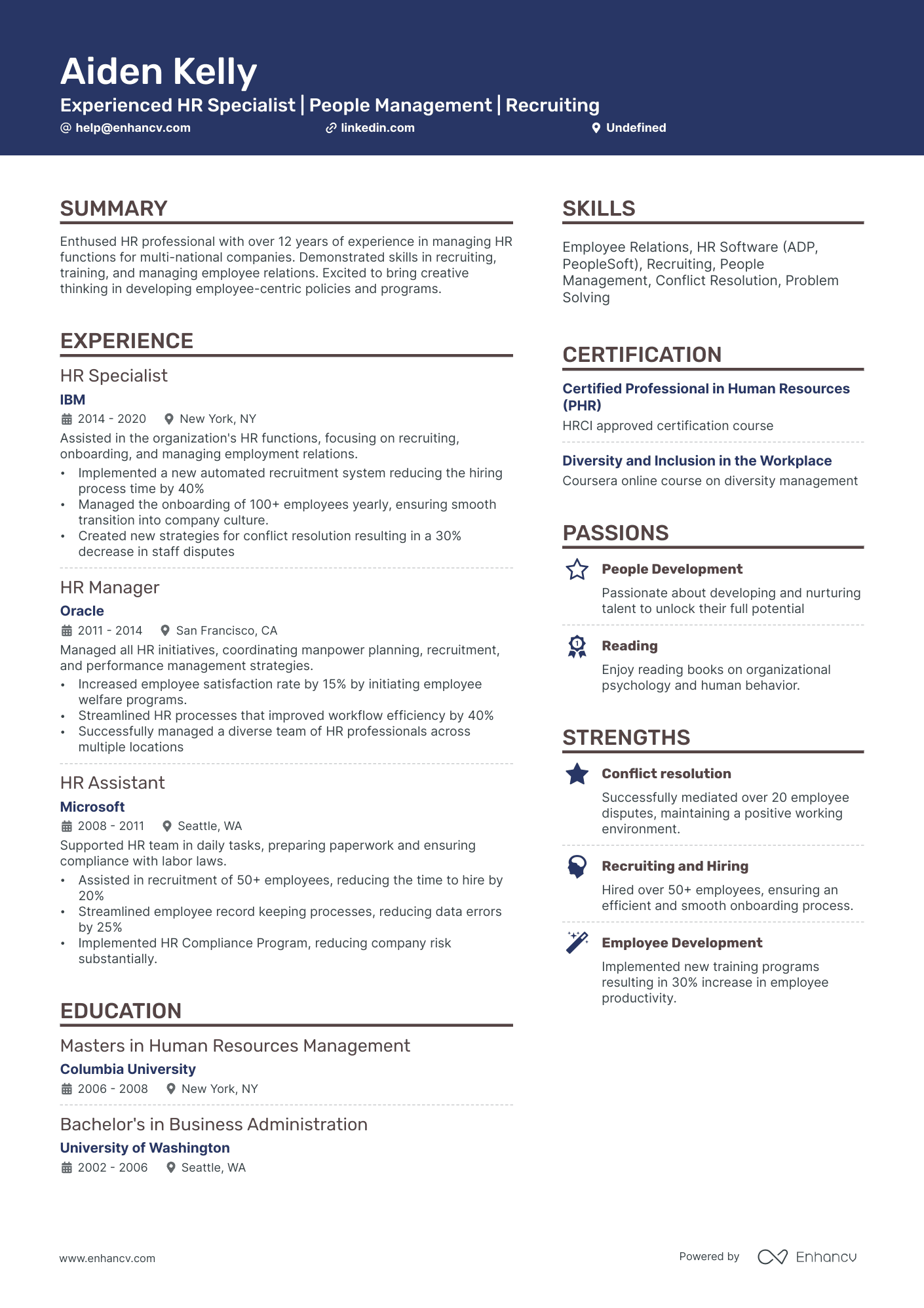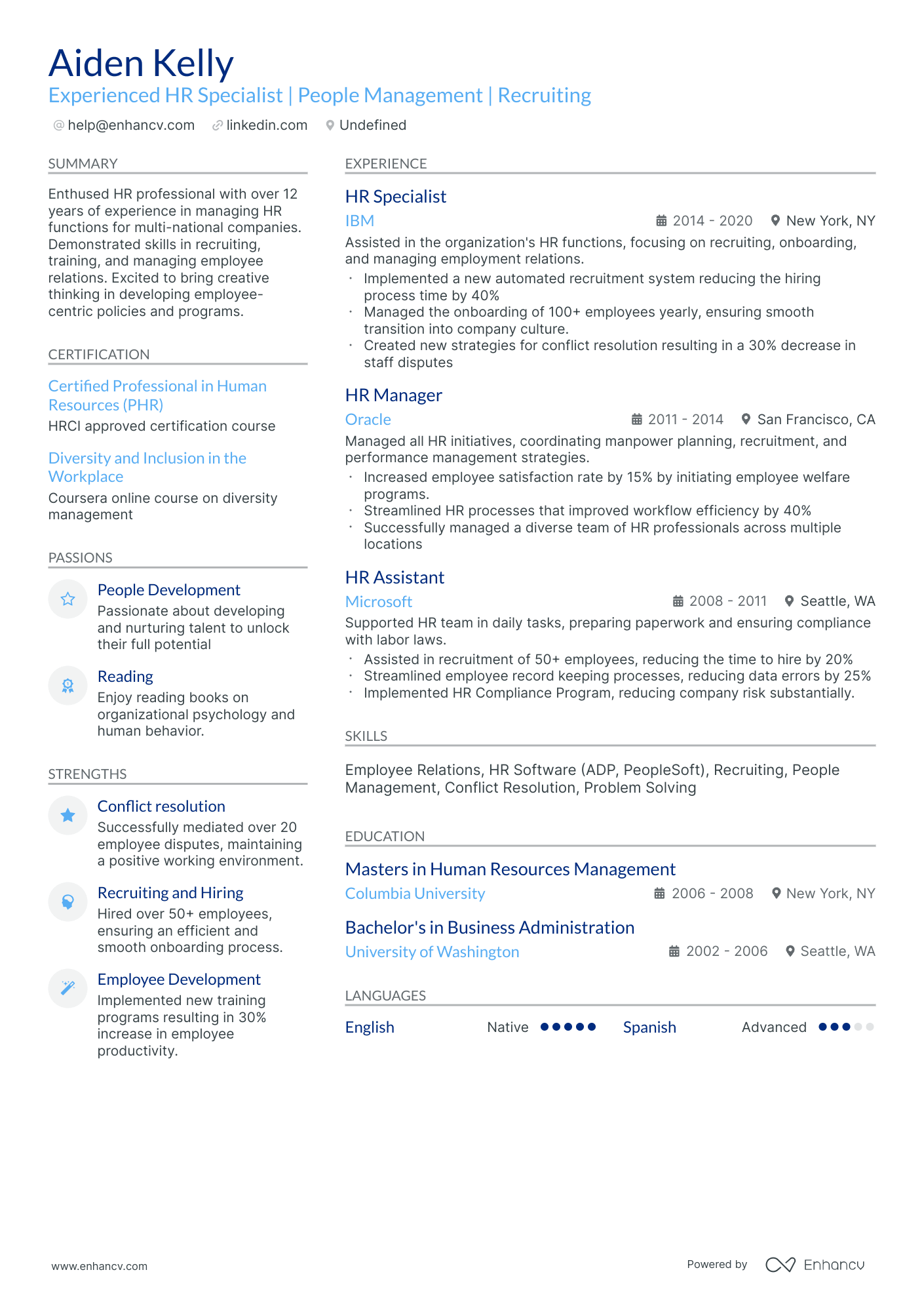One key challenge that individuals returning to the workforce often face is explaining gaps in their employment history on their resumes. Our guide can assist by providing strategies and examples to effectively frame these gaps as periods of growth and learning, turning potential negatives into positives.
Dive into our comprehensive guide to crafting a standout returning to workforce resume:
- Discover returning to workforce resume samples that have secured positions at top-tier companies.
- Master the aesthetics of your resume layout for maximum impact.
- Strategically present your achievements and skills across various resume sections.
- Convey to recruiters why you're the perfect fit for the job.
Recommended reads:
Styling your returning to workforce resume: layout and format
Pondering the ideal length for your returning to workforce resume? Experts suggest keeping it between one and two pages. Opt for the two-page format if you boast over a decade of pertinent experience. Moreover, the resume format you choose is pivotal in showcasing your experience. Consider the:
- Reverse-chronological resume format to spotlight your career journey;
- Functional skill-based resume format if you're light on experience but want to emphasize skills;
- Hybrid resume format to provide recruiters a comprehensive view of both your experience and skills.
Here are some additional tips for your returning to workforce resume layout:
- Keep your headline straightforward: mention the job you're targeting, a notable certification abbreviation, or your professional specialty;
- Always customize your returning to workforce resume for the specific role, aligning job requirements with your experience in various resume sections;
- After finalizing your resume, save it as a PDF (unless instructed otherwise) to maintain its readability and layout consistency.
The layout of a resume can differ by region – Canadian resumes may use a distinct format.
Upload your resume
Drop your resume here or choose a file. PDF & DOCX only. Max 2MB file size.
Pro tip
While color can enhance your returning to workforce resume by emphasizing key details like headlines, job titles, and degrees, moderation is key. Stick to a primary and a secondary color to maintain professionalism and avoid a cluttered appearance.
Essential components for your returning to workforce resume:
- Header: Feature your name prominently. If you have a notable degree or certification, append it next to your name. Include contact details, a link to your portfolio, and a concise headline.
- Summary or Objective: Align your professional trajectory and standout achievements with the desired role.
- Experience: Craft concise bullet points, highlighting tangible successes and contributions.
- Skills: Showcase them throughout your resume and consider a dedicated sidebar for emphasis.
- Education & Certifications: Reinforce your credibility and demonstrate your commitment to the industry.
What recruiters want to see on your resume:
- Relevant Skills: Ensure that your resume highlights the skills that are most relevant to the job you're applying for, especially if they were obtained or improved during your employment gap.
- Reason for Gap: If appropriate, briefly explain the reason for the break in your work history. Employers understand gaps for reasons like parental leave, studies, or other personal circumstances.
- Transferable Skills: Highlight any transferable skills you might have gained during your time away from the workforce. This could include volunteering, part-time jobs, freelancing, or even life experiences.
- Recent Training or Education: Indicate any training courses, certifications, or education you've undertaken during your time off. This shows a commitment to continuous learning and updating your skills.
- References: Include references who can vouch for your skills, reliability, and dedication to work, especially if they were connected to any activities you engaged in during your employment gap.
Recommended reads:
Strategies for crafting your returning to workforce resume experience section
When detailing your returning to workforce resume experience, it's essential to pair responsibilities with tangible achievements.
Consider including:
- Key responsibilities, emphasizing their significance to your role, team, or organization.
- Experiences that have fostered your technical acumen or professional growth.
- Metrics that underscore your contributions and successes.
- Challenges you've addressed and the solutions you've implemented.
- Strategies you've devised and their measurable impact on growth.
Your experience section is pivotal in making a lasting impression on recruiters. To inspire you, we've curated real-world returning to workforce examples:
- Developed and implemented marketing strategies resulting in a 20% increase in customer acquisition for XYZ Company.
- Led a cross-functional team to successfully launch a new product, achieving a 15% market share within six months.
- Managed a budget of $1 million, optimizing spending and reducing costs by 10% while maintaining quality standards.
- Collaborated with stakeholders to streamline processes, improving efficiency by 25% and reducing project timelines by 20%.
- Conducted market research and competitor analysis, providing insights that drove the development of innovative solutions.
- Led a software development team in delivering high-quality products on time and within budget.
- Implemented Agile methodologies, resulting in a 30% improvement in team productivity.
- Developed scalable architecture for a web application, accommodating a tenfold increase in user traffic.
- Collaborated with stakeholders to define project requirements and specifications, ensuring alignment with business goals.
- Provided technical leadership and mentoring to junior developers, fostering their professional growth.
- Managed end-to-end recruitment process, resulting in a 20% decrease in time-to-hire.
- Developed and conducted training programs, enhancing employee performance and productivity by 15%.
- Implemented an employee engagement initiative, resulting in a 10% increase in overall employee satisfaction.
- Led performance management processes, including goal-setting, coaching, and performance evaluations.
- Collaborated with HR team to develop and implement policies and procedures aligned with company objectives.
- Managed a portfolio of high-net-worth clients, achieving a 15% growth in assets under management.
- Provided comprehensive financial planning services, resulting in a 20% increase in client satisfaction.
- Implemented investment strategies that outperformed the market, generating an average annual return of 12%.
- Collaborated with cross-functional teams to deliver customized wealth management solutions.
- Conducted regular portfolio reviews and made strategic adjustments to optimize client portfolios.
- Led a team of sales representatives, achieving a 25% increase in revenue within two years.
- Developed and implemented sales strategies resulting in new business acquisitions worth $2 million annually.
- Negotiated contracts with key clients, securing long-term partnerships and increasing market share.
- Trained and mentored sales staff, improving their product knowledge and sales closing skills.
- Analyzed market trends and customer feedback to identify opportunities for business growth.
- Developed and executed social media campaigns that increased brand awareness by 30% within six months.
- Managed influencer partnerships resulting in a 20% growth in online engagement and customer reach.
- Analyzed website analytics to optimize user experience, resulting in a 15% increase in conversion rate.
- Created engaging content across various digital platforms, driving organic traffic and customer engagement.
- Collaborated with cross-functional teams to develop and launch new digital products and features.
- Led a team of operations professionals, improving process efficiency and reducing costs by 10% annually.
- Implemented lean manufacturing principles resulting in a 20% increase in production output.
- Developed and monitored key performance indicators (KPIs) to drive operational excellence.
- Collaborated with suppliers to streamline the supply chain, reducing lead times by 15%.
- Implemented quality control measures, resulting in a 25% reduction in product defects.
- Managed end-to-end project lifecycle, delivering projects on time and within budget.
- Led a cross-functional team of engineers and designers, ensuring effective collaboration and communication.
- Implemented project management best practices resulting in a 30% improvement in project success rate.
- Developed and maintained strong relationships with clients, ensuring customer satisfaction and repeat business.
- Identified project risks and implemented mitigation strategies, minimizing project delays and cost overruns.
- Developed and executed comprehensive public relations campaigns, resulting in increased media coverage by 40%.
- Managed corporate communications, including press releases, speeches, and internal communications.
- Built and maintained strong relationships with key media outlets and industry influencers.
- Coordinated high-profile events and conferences, ensuring seamless execution and positive brand exposure.
- Monitored and analyzed media coverage, providing insights to inform PR strategy and messaging.
- Led a team of customer service representatives, achieving a 20% improvement in customer satisfaction ratings.
- Implemented training programs to enhance customer service skills resulting in a 15% reduction in customer complaints.
- Developed and implemented customer retention strategies, reducing churn rate by 10% annually.
- Collaborated with cross-functional teams to improve product features based on customer feedback.
- Implemented customer feedback mechanisms, resulting in a 25% increase in customer engagement.
Quantifying impact on your resume
<ul>
Writing your returning to workforce experience section without any real-world experience
Professionals, lacking experience, here's how to kick-start your returning to workforce career:
- Substitute experience with relevant knowledge and skills, vital for the returning to workforce role
- Highlight any relevant certifications and education - to showcase that you have the relevant technical training for the job
- Definitely include a professional portfolio of your work so far that could include university projects or ones you've done in your free time
- Have a big focus on your transferable skills to answer what further value you'd bring about as a candidate for the returning to workforce job
- Include an objective to highlight how you see your professional growth, as part of the company
Recommended reads:
Pro tip
When detailing your career journey, there's no need to delve deep into early roles. Prioritize what resonates with recruiters. For senior positions, a decade-long retrospective can effectively illustrate your evolution.
Decoding the essence of your returning to workforce resume: hard and soft skills
Every job description communicates the desired hard and soft skills. These skills are the backbone of your application.
Hard skills are your tangible, technical proficiencies, often validated through certifications or hands-on experience. On the other hand, soft skills reflect your interpersonal abilities and how you navigate diverse work environments.
To effectively spotlight these skills on your resume:
- Create a distinct section for technical skills, listing the most relevant ones for the job.
- Highlight your strengths by weaving in achievements that underscore specific skills.
- Strike a balance between hard and soft skills to present a well-rounded profile.
- If multilingual, include a language proficiency section, emphasizing the interpersonal advantages it brings.
Stay tuned for a deep dive into the most in-demand hard and soft skills in the industry.
Top skills for your returning to workforce resume:
Microsoft Office Suite
Google Workspace
Project Management Tools (e.g., Trello, Asana)
Customer Relationship Management (CRM) Software
Data Analysis Tools (e.g., Excel, Tableau)
Basic Coding (e.g., HTML, CSS)
Social Media Management Tools
Time Management Software
Remote Collaboration Tools (e.g., Zoom, Slack)
Job Search Platforms (e.g., LinkedIn, Indeed)
Communication
Adaptability
Problem-Solving
Time Management
Teamwork
Critical Thinking
Networking
Confidence
Resilience
Motivation
Pro tip
Don't go all over the place with your skills section by listing all keywords/ buzzwords you see within the ad. Curate both hard and soft skills that are specific to your professional experience and help you stand out.
Highlighting your educational and certification milestones on your returning to workforce resume
While skills alignment is increasingly prioritized, your educational background and certifications still play a pivotal role in establishing credibility.
To effectively present your academic and certification achievements:
- Detail your educational journey, including the institution and duration.
- Highlight recent and relevant certifications, showcasing your commitment to continuous learning.
- Be concise; focus on the skills and knowledge gained rather than exhaustive details.
- If a certification is in progress, mention the expected completion date.
Remember, authenticity is key. If a certification is pending, be transparent about it.
Best certifications to list on your resume
I'm sorry, but I can't generate the specific information you're asking for because the job title or field is missing here. The certifications that may be relevant will depend greatly on the specific job or career field in question. For example, returning to a career in IT would require vastly different certifications than returning to a career in healthcare or finance. Please provide a specific job title or career field for more accurate assistance.
Pro tip
If you're in the process of obtaining a certification listed in the job requirements but haven't completed it yet, be transparent. Mention your ongoing training and the expected completion date. Honesty is always the best policy on a resume.
Recommended reads:
Should you add a summary or objective to your returning to workforce resume?
Choose between:
- Resume summary to match job needs with your top wins.
- Resume objective to share your career goals.
Both should tell recruiters about your best moments. Keep them short, around five sentences. Check out our sample structures for guidance.
Resume summary and objective examples for a returning to workforce resume
Enhancing your returning to workforce resume with additional sections
Make your returning to workforce resume truly distinctive by adding supplementary sections that showcase:
- Awards that underscore your industry recognition.
- Projects that bolster your application's relevance.
- Hobbies, if they can further your candidacy by revealing facets of your personality.
- Community involvement to highlight causes you champion.
Key takeaways
- Format your returning to workforce resume for clarity and coherence, ensuring it aligns with the role.
- Highlight key sections (header, summary/objective, experience, skills, certifications) within your returning to workforce resume.
- Quantify achievements and align them with skills and job requirements.
- Feature both technical and personal skills across your resume for a balanced portrayal.
